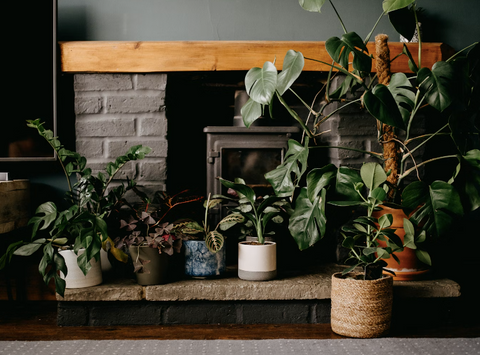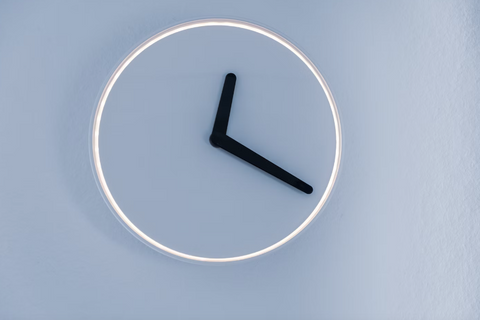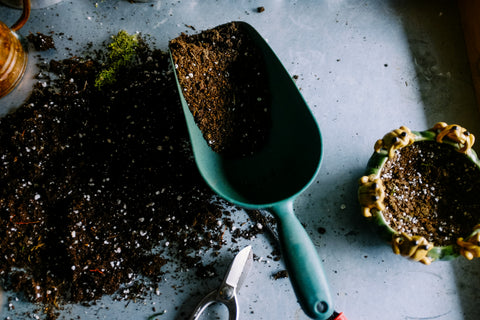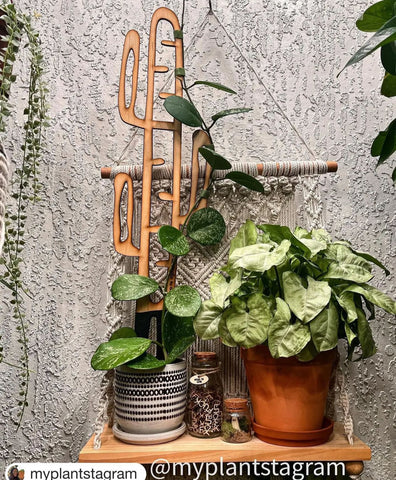Our Top Tips for Healthy Houseplants
Pick a plant that works with your light
Proper lighting is crucial when it comes to growing houseplants. Light helps houseplants photosynthesize, which will help your plant produce new growth and help your plant thrive in your house. Start out, by figuring out the type of lighting your houseplants require. Are they understory plants, like a Monstera deliciosa? Do they like to get baked by the sun all day, like Cacti and Euphorbia?

A group of plants on a fire place
Photo by Annie Spratt on Unsplash
It, also, helps to figure out which direction your windows face. Generally, south-facing windows receive the most amount of light. This is ideal for those sun loving houseplants. While, north-facing windows receive the least amount of light. These are good for Snake or ZZ plants.
If the sunlight in your house is too bright, you can also add a sheer curtain to cut back on the intensity. And if the amount of sunlight is too little, and you notice your plant suffering, adding grow lights is always recommended.

Plants under a growlight
Click here to learn more about grow lights.
Click here to learn more about lighting and growing house plants.
Pick plants that work with your schedule
If you're a new plant parent, take into consideration your daily schedule. Do you travel or go out a lot? Or are you more of a home body and have a lot of time to tend to your plants? It's best to find houseplants that suit your life style so you're not stressing over a plant you can't give enough attention to or you're not killing your houseplant by caring for it constantly when it requires little care.

Learn how to water your plants
Along with proper lighting, learning when to water your houseplant is crucial. Does your plant like to be watered more often or as often as you pay rent? When understanding a new plant, it's better to under water than over water. Too much water, can lead to root rot which can be difficult to fix.
Look for signs that your plant needs a watering. Signs like; curled leaves, dry soil or your plant all the sudden goes limp. This is when you know your plant is ready to be watered. And when watering time comes, make sure to thoroughly water your plant. Don't just pour a bit of water in the soil and call it a day. Instead, let water run through the soil a few times or let it soak up water through the drainage hole.

A group of plants on a table after being watered
Photo by Annie Spratt on Unsplash
The conditions of your house and the time of the year will also determine when your houseplants need to be watered. And it's important to keep an eye on your plant closely when the seasons first change. For example, you'll see a lot of plant experts recommend that you water your plant less in the winter time. Due to the lack of sunlight hours, houseplants grow more slowly and absorb water at a slower rate. However, if your plants are in a small room, or by a vent, and you have the heat running, you may find yourself watering your plants a lot more often. Dry air will dry your houseplants out quicker than when they're fully growing during the growing season.
Understanding soil
While I wouldn't put this at the top of your priority list when you're first getting into houseplants, understanding soil and the type your plant needs will drastically make a difference in your plant care. To keep it simple, if you tend to over water your plants, make sure to add extra amendments to your plant soil. Amendments are things like, horticultural charcoal, perlite or orchid bark, that can help aerate the plant soil. Aerating the soil helps add air, or space, between the roots and the soil so the plant roots aren't constantly sitting in over saturated soil. However, if you tend to under water your plants, minimize the amount of additives.
Click here to learn more about soil.
Don't be afraid to repot
Repotting a plant into fresh soil and a new pot can be quite daunting. But, fear not, plants are a lot more resilient than you may think. If your plant is more thirsty than normal, maybe it needs watering on a daily basis when you know it use to be fine with weekly waterings, then maybe it needs a repot. Or you notice a lot of roots growing out of the drainage hole, then you need to repot too. Depending on how root bound your plant is, you might need to use a hand held shovel and gently scrape around the outer edges of the pot to loosen up the plant and detach the roots from the planter it is in. Then carefully shovel the plant out of the pot. Look for a planter or pot that's 2-4inches bigger than the current one it was in. Once its repotted, if the soil feels a bit dry, give it a good watering and place it in enough light to make sure it acclimates to its new environment smoothly.

Raise humidity levels when needed
While not all plants require humidity to thrive, most houseplants, especially tropical plants, will do best with some sort of humidity. Researching your plant and understanding your plants natural environment is one plant care tip I don't see often enough. Some quick ways to increase humidity, would be to group your plants together and create a microclimate. Or getting a humidifier and placing your most humidity loving plants close by. But, if you collect more cacti and succulent, no need to worry about humidity, they prefer more direct light and drier air.
Opt for drainage holes
Drainage is always something to keep in mind when growing houseplants, especially if you over water your houseplants. Along with proper soil aeration, opt for plant pots with drainage holes. The drainage holes will allow excess water to drain out from the bottom of the pot, helping prevent the roots from rotting. If you have a pot without holes, you could drill a hole at the bottom or, the easier option, use a nursery pot and use the outer pot as a cache pot.
Regularly check for plant pests
Plant pests can be detrimental to your houseplants. So make sure to make it a habit to check for different insect pests while doing you plant chores. This could be as simple as closely inspecting the stems of the plants as well and the top and underside of the leaves. You could follow with a monthly spray down with a pest prevention solution or DIY a spray you could use to clean the leaves.
Click here if you want to learn more about the different types of houseplant pests.
Remove Dust From Plants
This goes hand in hand with checking your houseplants for pests. Scheduling time to give your houseplants some TLC and wipe down the leaves will do heaps in preventing plant pests, especially spider mites. Taking this time with your houseplants will also help catch problems early on before the spread and cause true chaos.
Cutting away leggy parts and yellowing leaves
When it comes to the look of your houseplants, many people will cut away yellow leaves and leggy growth. Cutting away leggy growth is actually a good method in letting your plants grow more bushy and put out new growth. What does "leggy" mean? Leggy growth simply means, when the internodal parts of your houseplants grow longer and it because less compact. This is often due to lack of light that often happens in winter.
Yellow leaves can be a bit unsightly and, while, often times, yellowing leaves are just a plants way of getting rid of old growth, they can also tell you about the overall health of your houseplants. Are the tops leaves getting yellow or just a few leaves? Is there a sudden onset of a lot of yellowing leaves or just one or two? When you noticed a sudden on set of yellowing leaves, especially at the top of the plant, this is a sign of either houseplant pests or some sort of stress.
Give them the support they need
Lot of tropical plants especially vining and climbing plants thrive when given the right support. These plants are climbers in their natural environment and grow on tree barks in nature. Some examples of these are Philodendrons, Monsteras, Hoyas or Pothos. These plants look beautiful trailing down but adding a support structure to help them climb can supercharge their growth. The leaves on the plants will mature faster (that means bigger leaves and fenestrations). A bamboo stake, a moss pole or a fancy designer trellis from Treleaf all would be fine.
Give it a try and your plants are going to thank you.

